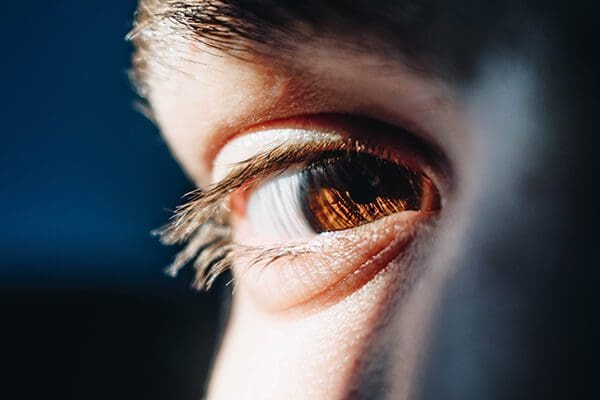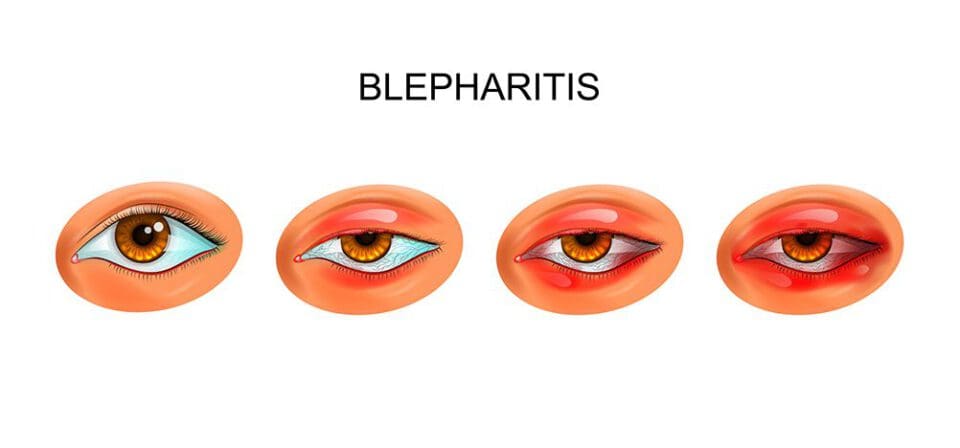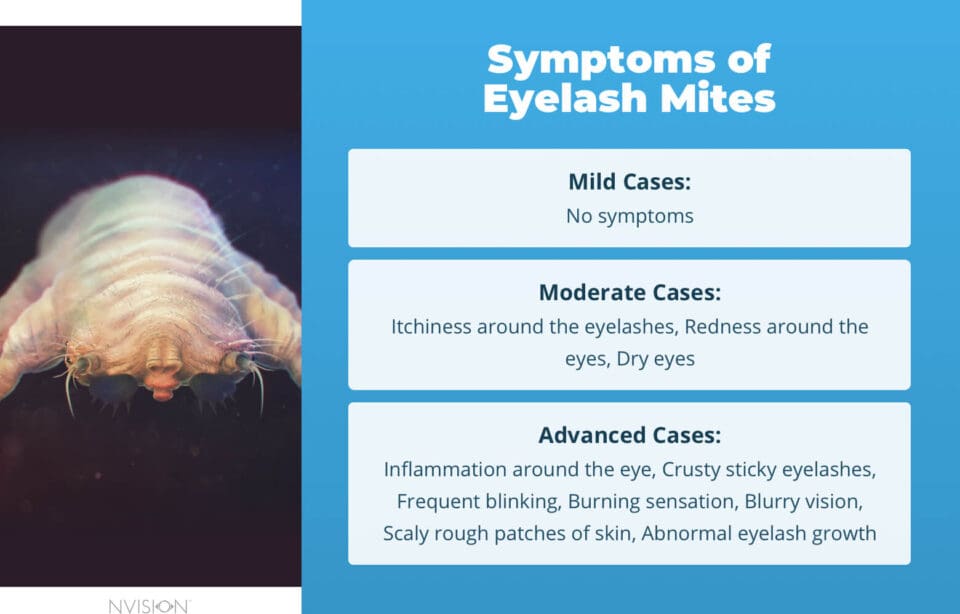Eyelash Mites: Symptoms & How to Get Rid of Them (Fast)
Home / Eye Conditions & Eye Diseases /
Last Updated:
Eyelash mites are a type of microscopic mite called Demodex that occurs naturally. These mites can be responsible for uncomfortable symptoms on the eyelid when an infestation is present.
Table of Contents
Eyelash mites are not typically dangerous and can actually serve helpful functions for the human skin. If there are too many, however, they can cause inflammation and infection around the eyes that need to be treated before your vision is affected.
Because eyelash mites occur naturally on the face, they are not caused by something specific. An infestation, however, has been linked to certain conditions, such as rosacea, dermatitis, inflammatory acne, and skin infections, among others.

Since eyelash mites are microscopic, you can’t see them, but you can identify symptoms they are causing. Symptoms of eyelash mites include itchiness, redness, dry eye, crusty and sticky lashes, blurry vision, and scaly or rough patches of skin around the eyes.
Both at-home and medical treatment methods are highly effective at controlling an eyelash mite outbreak. Warm soaks of the eye lids, and thorough cleaning of the eyes and face multiple times a day, can treat most cases of eyelash mites. Severe cases may need the help of antibiotic or steroid eye drops or cream.
Utilizing at-home and medical treatment options will likely clear up an eyelash mite infestation within a couple days. For stubborn or chronic cases, treatment approaches like Avenova, Blephadex, and Cliradex can provide relief almost instantly.
If you have an eyelash mite infestation, it is important to exercise extra eyelid hygiene. Avoid sharing cosmetics that touch the eye or coming into close physical contact with others. The sooner you seek medical care the better, as symptoms will get worse the longer you wait to treat the infestation.
Eyelash Mites: What Are They?
Problems associated with eyelash mites are caused by microscopic mites. They occur naturally on hair follicles and feed on dead skin cells on your body. Most people have a small amount of Demodex on their skin and don’t know it.
People with both good and poor hygiene have mites on their skin, as they are a naturally occurring organism. The prevalence of Demodex mites increases, however, with age and poor hygiene. Studies have found that everyone over the age of 70 has Demodex mites, while 84 percent of people over the age of 60 have the mites.
You deserve clear vision. We can help.
With 135+ locations and over 2.5 million procedures performed, our board-certified eye surgeons deliver results you can trust. Your journey to better vision starts here.
Demodex mites can be harmful or helpful to your skin, depending on their concentrations. In small amounts, as they typically naturally occur, the mites help rid your skin of dead cells and waste, and they contribute to a healthy human microbiome. If too many eyelash mites are present, they can lead to skin and eye complications that require proper treatment.
Are Eyelash Mites Dangerous?
Eyelash mites are known to cause a condition called Demodex blepharitis. It is a common condition that refers to inflammation of the eyelids. There are various causes of blepharitis, one of which is eyelash mite infestation.
Demodex folliculorum is the species of mites that is responsible for causing blepharitis and problems associated with the eyelashes. This species of mites can cause anterior blepharitis, or inflammation around the eyelid where the eyelashes attach to the eye.
Blepharitis is typically not contagious or highly dangerous, explains the American Optometric Association (AOA). Large infestations can spread to people who come in contact with the mites.
Though relatively harmless, blepharitis is uncomfortable and can be a recurring condition. Permanent damage to eyesight is not likely to occur in most cases.

Causes of Eyelash Mites
Demodex mites feed on dead skin, so people prone to dandruff or skin conditions, such as rosacea, are at a greater risk of developing eyelash mite infestations. While the mites themselves occur naturally, underlying conditions can cause their populations to bloom on your skin.
Eyelash mite outbreaks have been linked to the following conditions:
- Rosacea
- Dermatitis
- Inflammatory acne
- Alopecia
- Skin infections
- Weakened immune system
- HIV
Many of the above conditions can lead to eyelash mite infestations because they cause an increased amount of dandruff on the skin, which the mites feed on. The National Rosacea Society has found, for example, that people who have rosacea have 18 times more Demodex mites on their skin than people without rosacea. While rosacea doesn’t directly cause more eyelash mites, it creates conditions where these mites can flourish.
Symptoms of Eyelash Mites

Eye symptoms caused by eyelash mites can be very uncomfortable and interfere with your ability to see clearly. Addressing symptoms early on is the best way to prevent the condition from becoming worse.
Symptoms of eyelash mites appear in varying levels of severity, including:
- Mild cases. There are no noticeable symptoms at this stage. With mild cases, most people don’t realize they have eyelash mites at all.
- Moderate cases. These cases involve itchiness around the eyelashes, redness around the eyes, and dry eyes.
- Advanced cases. Symptoms progress to include inflammation around the eye, crusty and sticky eyelashes, frequent blinking, a burning sensation, blurry vision, and scaly and rough patches of skin. Abnormal eyelash growth occurs with severe ongoing cases.
You are most likely to experience symptoms of eyelash mites if you have an exceptionally large infestation or an underlying skin condition. If you have a pre-existing skin condition, such as rosacea or eczema, Demodex mites can temporarily make the condition worse. It’s important that you see a doctor to manage these more complex cases.
You deserve clear vision. We can help.
With 135+ locations and over 2.5 million procedures performed, our board-certified eye surgeons deliver results you can trust. Your journey to better vision starts here.
Treatment Methods for Eyelash Mites
The treatment of blepharitis caused by eyelash mites is focused on keeping your eyelids free of crusts, so mites and their eggs do not have a place to live and grow.
For mild to moderate cases of eyelash mites, the following at-home treatments are recommended:
- Apply warm compresses to loosen crust on the eyelid.
- Lightly scrub your eyelid to remove crust.
- Use a mixture of water and baby shampoo to clean your eyelids.
- Thoroughly clean your eyes and face two to three times daily.
In severe cases of eyelash mite infestation or when a bacterial infection is present, medical intervention may be necessary. Medical treatments for blepharitis include:
- Antibiotic eyelid creams.
- Steroid eye drops.
AOA recommends warm soaks of the eyelids as one of the top self-care measures for addressing eyelash mites. Additional self-care steps to reduce symptoms caused by eyelash mites include:
- Use artificial tears or lubricating ointments if dry eye is a problem.
- Use anti-dandruff shampoo on the scalp.
- Stop wearing eye makeup until the mite outbreak is under control. Throw away old makeup that was used around the eyes during the infestation.
- Don’t wear contact lenses until treatment is complete.
Many cases of eyelash mites are recurring, so ongoing proper eye hygiene is important for preventing future outbreaks. Blepharitis rarely disappears entirely, explains AOA, so it is important to stay vigilant about identifying symptoms early and keeping them under control.
Treatment Timeline

The use of at-home and medical treatment options for eyelash mites should clear up infestations within a few days to a week. Chronic cases, however, can be more challenging to get rid of. Symptoms may clear up after a few days only to return a couple weeks later.
For these persistent cases, a few blepharitis-specific treatments have been developed.
- Avenova: This is a daily eyelash and lid hygiene system that utilizes 0.01 percent of hypochlorous acid (a naturally occurring chemical) to destroy mites and their toxins. Avenova is meant to be used twice a daily and is effective almost immediately.
- Blephadex: This is a treatment that eye doctors perform in their offices. Blephadex targets Demodex mites with a mixture of a gentle eyelid cleanser, tea tree oil, and coconut oil with anti-inflammatory and analgesic properties.
- Cliradex: Individually packaged moist towelettes are soaked in a natural and preservative-free eyelid and lash cleanser that contains isolated 4-Terpineol, the active ingredient in tea tree oil. The wipes should be applied to the eyes twice a day for about 10 days. Difficult or chronic cases can be treated with a single application for another 10 days, though the product is safe to use daily as a regular eye and face cleanser.
What to Avoid When You Have Eyelash Mites
Although eyelash mites are generally not contagious, severe infestations can be, so it is important to exercise caution if you or someone close to you has eyelash mites.
If you have a serious case of eyelash mites, consider the following recommendations:
- Avoid close contact with other people.
- Do not share eye makeup, including mascara, eye shadow brushes, or any cosmetics that may routinely come into contact with the eyelash or eyelid.
- Resist rubbing or scratching your eyes.
- Avoid oily makeup and lotions.
- Wash all sheets and bedding in hot water.
If you live with someone who has a severe case of eyelash mites, get evaluated. It’s likely that you also have eyelash mites.
If you have eyelash mites that are causing noticeable discomfort, it is important to seek prompt treatment. When addressed early on, eyelash mites are easily treatable and unlikely to cause any further vision changes or eyelid damage.
To get a definitive diagnosis of eyelash mites, a doctor will view a pulled eyelash under a microscope. Generally, some eyelash mites will remain on the eyelash after it is pulled from your eyelid. The doctor will use a slit lamp on high magnification to see the mites.
The goal of treatment is to get rid of the adult mites, prevent further offspring, and alleviate the patient’s symptoms. Most cases of eyelash mites can be effectively treated within a few weeks.
Eyelash Mites FAQs
Are eyelash mites contagious?
In the event of a severe infestation, eyelash mites can be transmitted from person to person through close contact. The cigar-shaped bugs usually infest the base of your eyelids, causing notable symptoms. Mild infections tend to be harmless and are unlikely to get transmitted to healthy individuals. But the mites are contagious, and patients with severe infestations should refrain from close physical contact to prevent spreading the microscopic bugs.
What are the symptoms?
Demodex mites can cause noticeable symptoms in large numbers. The symptoms may vary depending on the severity of the infestation, but they include the following:
- Swollen eyelids
- Itchiness, irritation, and a burning sensation
- Crusty deposits around the eyes
- Watery eyes
- Blurred vision
- Falling eyelashes
- Eye infections
Do you need to see a doctor?
Mild cases of Demodex mite infestations may clear up with time. However, if you experience uncomfortable symptoms, you should consider getting treatment to alleviate them. The most common remedy is tea tree oil, an essential oil that alleviates symptoms and reduces the naturally occurring bugs. You may need to speak to a doctor before using any home remedies to clear up an eyelash mite infestation.
You deserve clear vision. We can help.
With 135+ locations and over 2.5 million procedures performed, our board-certified eye surgeons deliver results you can trust. Your journey to better vision starts here.
References
- 3 Ways to Treat Chronic Blepharitis. (January 2020). Verywell Health.
- Blepharitis. American Optometric Association.
- Blepharitis. (July 2019). National Eye Institute.
- Eye Mites Symptoms and Causes. (January 2020). Verywell Health.
- What Are Eyelash Mites and How Do You Know if You Have Them? (December 2018). Women’s Health.
- Pathogenic Role of Demodex Mites in Blepharitis. (October 2019). National Institutes of Health: Current Opinion in Allergy and Clinical Immunology.
- The Ecology of Your Face: Demodex, Rosacea and You. National Rosacea Society.
- Demodex Infestation Requires Immediate, Aggressive Treatment by Doctor, Patient (June 2011). Healio.
- What to know about eyelash mites. (September 2020). Medical News Today.
- Eyelash Mites: What to Know. (December 2018). Healthline.
This content is for informational purposes only. It may have been reviewed by a licensed physician, but is not intended to serve as a substitute for professional medical advice. Always consult your healthcare provider with any health concerns. For more, read our Privacy Policy and Editorial Policy.